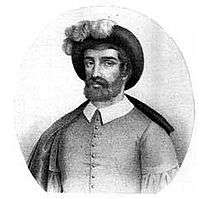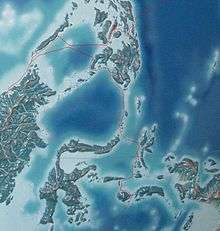Juan Sebastián Elcano
| Juan Sebastián Elcano | |
|---|---|
 | |
| Born |
Juan Sebastián Elcano 1476 Getaria, Gipuzkoa, Crown of Castile |
| Died |
August 4, 1526 (aged 49–50) Pacific Ocean |
| Cause of death | Malnutrition |
| Nationality | Basque, Castilian (state) |
| Occupation | explorer, navigator and mariner |
| Known for | first circumnavigation of the earth |
| Religion | Roman Catholic |
| Partner(s) | María Hernández Dernialde |
| Children | Domingo Elcano III |
| Parent(s) | Domingo Sebastián Elcano I, and Catalina del Puerto |
| Relatives | Domingo Elcano II, Martín Pérez Elcano and Antón Martín Elcano |
Juan Sebastián Elcano[1] (1476 – 4 August 1526) [alternative: Juan Sebastián del Cano] was a Spanish explorer of Basque origin[2][3][4] who completed the first circumnavigation of the Earth. After Magellan's death in the Philippines, Elcano took command of nau Victoria from the Moluccas to Sanlúcar de Barrameda in Spain.
Early life
Elcano was born in 1476 to Domingo Sebastián Elcano and Catalina del Puerto. He had three brothers: Domingo Elcano, a Catholic priest, Martín Pérez Elcano, and Antón Martín Elcano.
Military life
Elcano fought in the Italian Wars under the command of Gonzalo Fernández de Córdoba in Italy, and in 1509 he joined the Spanish expedition organized by Cardinal Francisco Jiménez de Cisneros against Algiers.
Merchant shipping
Elcano settled in Seville and became a merchant ship captain. After breaking Spanish laws by surrendering a ship to Genoan bankers in repayment of a debt, he sought a pardon from the Spanish king Charles V, by signing on as a subordinate officer for the Magellan expedition to the East Indies.
Voyage of circumnavigation

Elcano served as a naval commander of Charles V of Spain and took part in the expedition to the Philippines. They set sail with five ships, Concepción, San Antonio, Santiago, Trinidad and Victoria with 241 men from Spain in 1519. Elcano participated in a fierce mutiny against Magellan before the convoy discovered the passage through South America, the Strait of Magellan. He was spared by Magellan and after five months of hard labour in chains was made captain of the galleon.[5] Santiago was later destroyed in a storm. The fleet sailed across the Atlantic Ocean to the eastern coast of Brazil and into Puerto San Julián in Argentina. Several days later they discovered a passage now known as the Strait of Magellan located in the southern tip of South America and sailed through the strait. The crew of San Antonio mutinied and returned to Spain. On 28 November 1520, three ships set sail for the Pacific Ocean and about 19 men died before they reached Guam on 6 March 1521. Conflicts with the nearby island of Rota prevented Magellan and Elcano from resupplying their ships with food and water. They eventually gathered enough supplies and continued their journey to the Philippines and remained there for several weeks. Close relationships developed between the Spaniards and the islanders. They took part in converting the Cebuano tribes to Christianity and became involved in tribal warfare between rival Filipino groups in Mactan Island.

On 27 April 1521, Magellan was killed and the Spaniards defeated by natives in the Battle of Mactan in the Philippines. The surviving members of the expedition could not decide who should succeed Magellan. The men finally voted on a joint command with the leadership divided between Duarte Barbosa and João Serrão. Within four days these two were also dead. They were killed after being betrayed at a feast at the hands of Rajah Humabon. The mission was now teetering on disaster and João Lopes de Carvalho took command of the fleet and led it on a meandering journey through the Philippine archipelago.
During the six-month listless journey after Magellan died, and before reaching the Moluccas, Elcano's stature grew as the men became disillusioned with the weak leadership of Carvalho. The two ships, Victoria and Trinidad finally reached their destination, the Moluccas, on 6 November. They rested and re-supplied in this haven, and filled their holds with the precious cargo of cloves and nutmeg. On 18 December, the ships were ready to leave. Trinidad sprang a leak, and was unable to be repaired. Carvalho stayed with the ship along with 52 others hoping to return later.[6]
Victoria, commanded by Elcano along with 17 other European survivors of the 240 man expedition and 4 (survivors out of 13) Timorese Asians continued its westward voyage to Spain crossing the Indian and Atlantic Ocean. They eventually reached Sanlúcar de Barrameda on 6 September 1522.[7]
Antonio Pigafetta, an Italian scholar, was a crew member of the Magellan and Elcano expedition. He wrote several documents about the events of the expedition. According to Pigafetta the voyage covered 14,460 leagues—about 81,449 kilometres (50,610 mi).
Honours
Elcano was awarded a coat of arms by Charles I of Spain, featuring a globe with the motto: Primus circumdedisti me (in Latin, "You went around me first"), and an annual pension.
Loaísa expedition
In 1525, Elcano returned to sea, and became a member of the Loaísa expedition. He was appointed leader along with García Jofre de Loaísa as captains, who commanded seven ships and sent to claim the East Indies for King Charles I of Spain. Both Elcano and Loaísa and many other sailors died of malnutrition in the Pacific Ocean, but the survivors reached their destination and a few of them managed to return to Spain.
Family life
Elcano never married but he had a son by María Hernández Dernialde named Domingo Elcano, whom he legitimized in his last will and testament. In 1572 to mark the 50th anniversary of the voyage King Philip II of Spain awarded the male heirs of Elcano the hereditary title of Marques de Buglas at Negros island in the Philippines. The lineage still survives and the current Marquis is the 17th in line. He resides in Silay City, Negros Occidental.
Another branch of the family ended up in the Netherlands with the family name Delcano. It is possible that the family may have moved to the Netherlands during the difficult years at the end of the 15th century when Jews and Moors were expelled from Spain under the reign of King Ferdinand II of Aragon and Queen Isabella I of Castile.
See also
References
- ↑ Elcano y no Cano
- ↑ Totoricagüena, Gloria Pilar (2005). Basque Diaspora: Migration And Transnational Identity. University of Nevada Press. p. 132. ISBN 9781877802454. Retrieved 8 March 2013.
- ↑ Facaros, Dana; Pauls, Michael (2 September 2008). Cadogan Guide Bilbao & the Basque Lands. New Holland Publishers. p. 177. ISBN 978-1-86011-400-7. Retrieved 7 January 2013.
- ↑ Salmoral, Manuel Lucena (1982). Historia general de España y América: hasta fines del siglo XVI. El descubrimiento y la fundación de los reinos ultramarinos. Ediciones Rialp. p. 324. ISBN 978-84-321-2102-9. Retrieved 7 January 2013.
- ↑ Murphy, Patrick J.; Coye, Ray W. (2013). Mutiny and Its Bounty: Leadership Lessons from the Age of Discovery. Yale University Press. ISBN 9780300170283.
- ↑ Humble, Richard (1978). The Seafarers—The Explorers. Alexandria, Virginia: Time-Life Books.
- ↑ Kattan-Ibarra, Juan (1995). Perspectivas Culturales de España. p. 71.
External links
- Juan Sebastián de Elcano
- Auñamendi Encyclopedia: Elcano, Juan Sebastián de (Spanish)
- Last will and testament of Sebastian Elcano